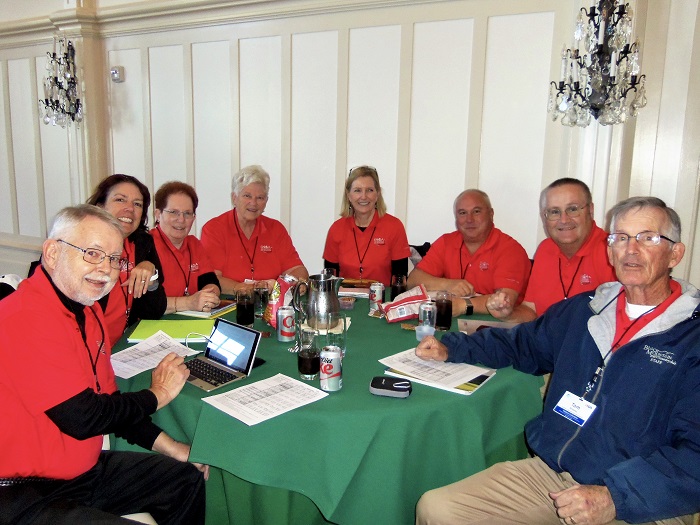Course Ratings Q&A With the Experts
All of us golfers kind of know what a course rating is and how it can impact our handicap, or, more importanly, our friendly Nassau or club tournament result. But do we really know? With that in mind, we enlisted Southern Nevada Golf Association course rating expert Jan Hansen in a question and answer session. After reading this, you’ll be a much more enlightened about what Jan and her team–and all United States Golf Association–course raters do and how it helps the game.
Several SNGA course rating experts including Hansen, Tim Quinn, Tom Kilmer, Lew Carlson, Jackie Pierson and Susan Daum recently attended a USGA seminar about how the new rules affect course rating. It was one of several seminars course raters attend to keep their skills and knowledge at peak capabilities.
SNGA Club News (SCN): What is the first thing that comes to your mind about the seminar?
Jan Hansen (JH): This particular seminar held on March 17-18 at Old Ranch Country Club in Seal Beach, California was one of the best and most productive calibration seminars our team has attended over the years. Because of the new Rules of Golf now in effect, this seminar was focused on how some of the new rules affect course rating. In particular, the USGA helped us understand and apply new procedures as it relates to the treatment of penalty areas, out of bounds and what constitutes extreme rough on the course.
SCN: What was the purpose of seminar?
JH: The USGA Handicap Department has conducted National Course Rating Calibration Seminars annually since 1989. These calibrations are conducted for experienced course raters and authorized golf association staff. This seminar provides an advanced educational opportunity to confirm that the USGA Course Rating System is being administered consistently and to fulfill the requirements in the collaboration/license agreement between the SNGA and the USGA. The seminar consists of a quiz, on-course evaluations, and educational sessions. These educational sessions give the attendees an opportunity to ask in depth questions of USGA staff as it relates to course rating procedures and propose changes to allow course raters to do a better job of evaluating courses. The USGA also provides updates on the World Handicap System, changes to GHIN and other USGA projects that may be of interest to course raters.
SCN: What is something you would like member clubs to know about SNGA course rating or course rating, in general?
JH: I will use the help of the official USGA information About Course Rating.
You might be reading this, asking yourself, “what exactly is course rating?”
Well, it is one of the most important duties we do here at Southern Nevada Golf Association. As the officially licensed authority by the USGA to rate courses, the SNGA oversees this process that, in layman’s terms, provides a USGA Course Rating and Slope Rating for all tees that are reasonably expected to be played by either men or women. But, there is much more to it.
What is Course Rating?
The USGA Course Rating System was implemented by the USGA on January 1, 1987. This System addresses the problem of portability of handicaps by adjusting a player’s Handicap Index according to the relative difficulty of the golf course being played.
As stated earlier, every golf course receives both a USGA Course and Slope Rating for each set of tees that is rated. The rating established for the scratch golfer is known as the Course Rating. There is also a rating for the bogey golfer known as the Bogey Rating. This Bogey Rating is not normally published, but is used to determine a Slope Rating. The Slope Rating is an evaluation of the relative difficulty of a course for players other than scratch. The USGA Course and Slope Ratings are then calculated and certified by the authorized golf associations before they are issued to the facility. These ratings are vital in calculating a person’s handicap for that particular course.
In providing this course rating service to our members and member clubs, the SNGA has a volunteer course rating team that measures and rates each golf course in Southern Nevada. The USGA requires that each course must be rated every 10 years or sooner if modifications or design changes are made to the course. Any new courses are generally rated 4-5 years after the initial rating to review any changes that may have been made to the course.
Accuracy and consistency are the keys to effective course rating. The course rating team must first accurately measure the course because yardage is the predominant factor in determining ratings. Scorecard yardage is not acceptable as a sole source of measurement and must be verified by the rating team. Measurements are made to determine the horizontal distance from the teeing ground to the center of the green along the intended line of play. The rating team must then correct the measured yardage for factors that affect the playing length, such as roll, changes in elevation, any forced lay-ups, doglegs, wind and altitude.
Once the course has been properly measured, obstacles that affect playing difficulty are then evaluated by the rating team in accordance with USGA established procedures and standards. These obstacles include topography, fairway width, recoverability from rough, number and depth of bunkers, penalty areas such as out of bounds, extreme rough and water, number of trees and density, and green surface speed and contour.
After evaluating the measurements and obstacle data, the information is then entered into the USGA Course Rating Program which calculates the Course Rating and Slope Rating for each set of tees that was rated. This information is then forwarded to each golf course facility for publication to its members.

Recent Posts
- Member Club Spotlight – Golf Syndicate Las Vegas
- Sue’s Rules Is Back – To Palm Or Hold It?
- Henderson, Ledes, Vaughan, Snyder Earn Titles at Southern Nevada Senior Am, Mid-Am
- Annual Silver Cup Brings Solheim Cup Feel to Northern, Southern Nevada Women Golfers
- Women’s SNGA Team Play 2024 Coming Down To Final Events

